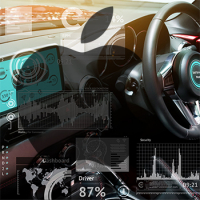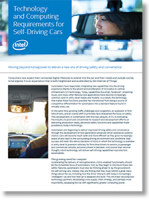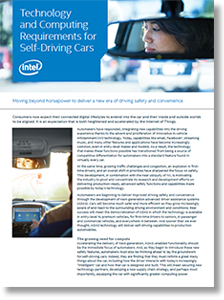Technology and Computing Requirements for Self-Driving Cars
The gathering momentum of next generation advanced driver assistance systems technology will revolutionize both the automobile itself and the auto industry, with a handful of automakers have already committed to introducing self-driving vehicles as early as 2020.
Moving beyond horsepower to deliver a new era of driving safety and convenience
Consumers now expect their connected digital lifestyles to extend into the car and their inside and outside worlds to be aligned.
It is an expectation that is both heightened and accelerated by the Internet of Things.
Automakers have responded, integrating new capabilities into the driving experience thanks to the advent and proliferation of innovative in-vehicle infotainment (IVI) technology.
Today, capabilities like email, Facebook*, streaming music, and many other features and applications have become increasingly common, even in entry-level makes and models.
As a result, the technology that makes these functions possible has transitioned from being a source of competitive differentiation for automakers into a standard feature found in virtually every car.
At the same time, growing traffic challenges and congestion, an explosion in first time drivers, and an overall shift in priorities have sharpened the focus on safety.
This development, in combination with the near ubiquity of IVI, is motivating the industry to pivot and concentrate its research and development efforts on delivering production-ready, advanced safety functions and capabilities made possible by today’s technology.
The evolution of the car: Why it matters
As cars grow more intelligent and more aware of their surroundings, consumers will expect increasingly sophisticated safety, security and convenience features and functions.
These can only be delivered through the development of next generation advanced driver assistance systems (ADAS) technology.
Successfully realizing the enormous opportunities of these automotive innovations has the potential to not only change driving - but also to transform society.
- Prevent the majority of all traffic accidents - Approximately 90 percent of accidents are driver error
- Lower the death rate for children under the age of 12 - Traffic accidents are the leading cause of death among children
- Decrease overall traffic deaths - About 1.3 million people a year are killed in car accidents
- Reduce the number injured in car accidents - Roughly 50 million are seriously injured in car accidents
- Reclaim lost productivity - American drivers spent 5.5 billion hours in their cars in 20114
- Save money - Traffic congestion costs drivers $121 billion in wasted time and fuel a year, or about $818 each
What’s Related


Favorites





